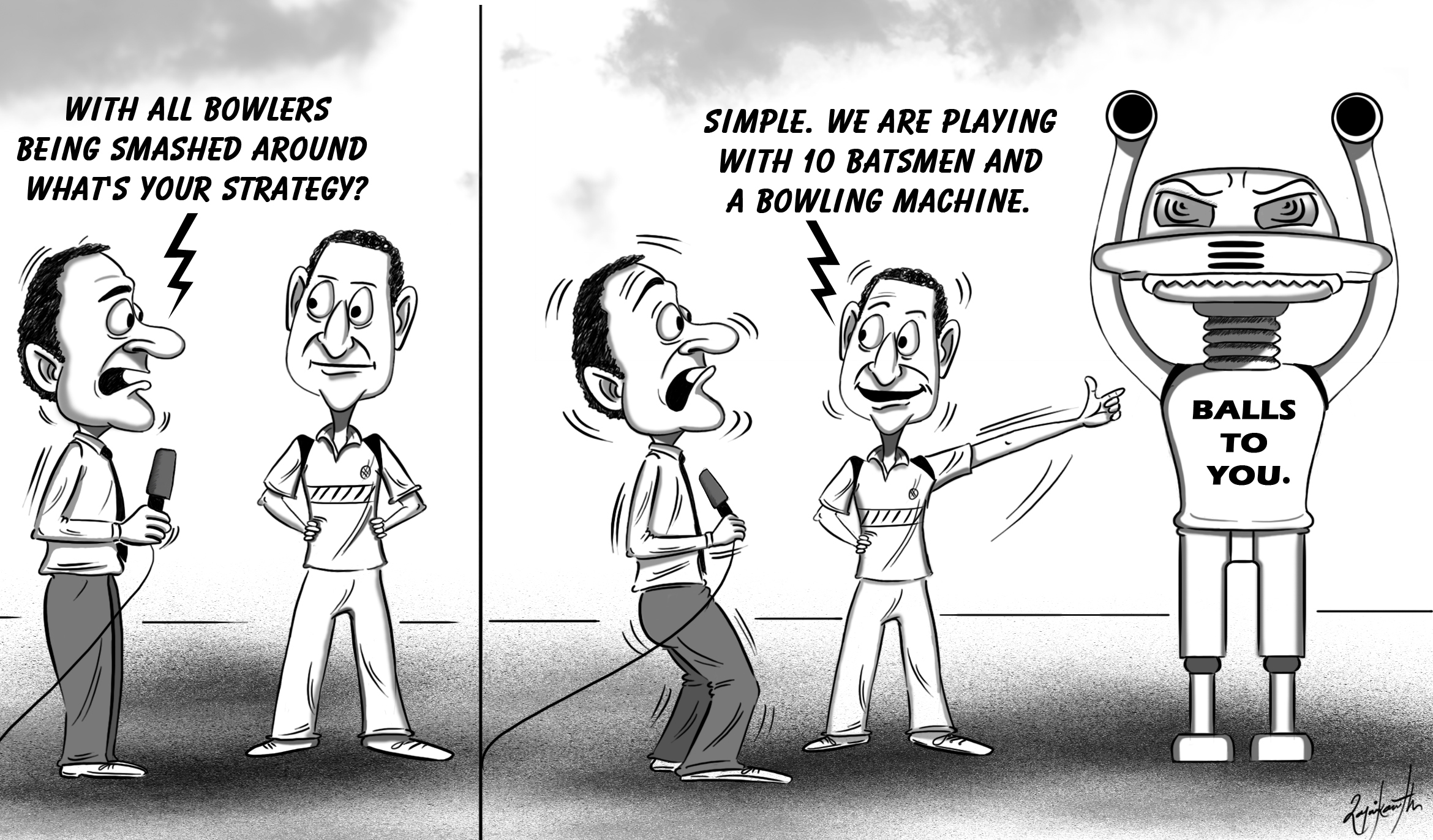 The crowd erupted; the big fast bowler seethed. The batsman, one of no great standing at that, had sweetly driven him back over his head for six. The shot had come out of the blue, and caught the audience, the bowler, and even the batsman himself--it is likely--by surprise.
The crowd erupted; the big fast bowler seethed. The batsman, one of no great standing at that, had sweetly driven him back over his head for six. The shot had come out of the blue, and caught the audience, the bowler, and even the batsman himself--it is likely--by surprise.
After the hit a noisy know-it-all, the kind you run into at almost every match, loudly and enthusiastically proclaimed that he knew exactly what would be coming. “If the next ball is not a bouncer,” he swore, “I will personally leave the ground.” No fast bowler, he explained, liked being hit back over his head like that and so the pacer was bound to retaliate with a fast, short, screaming delivery, or at least an attempt at one. But the follow-up delivery was full and our talkative friend fell silent and our ears were spared the incessant chatter for a few overs.
This, I’m guessing, was some time in the early 1990s. I’m not sure if the game was a test match; it might have been a regional first-class game. Though I don’t remember the protagonists, the venue was Sabina Park, Jamaica, and I was seated in what was then the Eastern stands. I recall the incident because of how significant a hit for six seemed back then. Nowadays, with the maximum hit becoming more and more a part of all varieties of the game, sixes are now commonplace, and would likely not have elicited the kind of reaction it did those years ago.
Recently, during a first-class game between Jamaica and Trinidad and Tobago, Jamaica’s number 10 batsman, Odean Brown, smashed a staggering seven sixes -- 42 of his runs -- in scoring 44. Indeed, 31 sixes were struck in the game, which was a relatively low-scoring affair, yielding a very modest 867 runs over four innings. This proportion of sixes was unheard of even a decade ago and it is permeating cricket at every level today.
Against Zimbabwe, during the 15th match of the current World Cup tournament, West Indian left-hander Chris Gayle, perhaps the game’s most powerful batsman, bludgeoned 215 runs off 147 deliveries, equaling the record for sixes struck in One Day Internationals in the process. He sent the ball over the boundary 16 times, matching the number of sixes slammed by AB de Villiers in his record-breaking innings against the West Indies a few weeks earlier, which itself had equaled Rohit Sharma’s Eden Garden effort against Sri Lanka in 2014.
I remember Gayle smoking a drive high over extra-cover; and I think there were at least two that were flicked over backward square. Mostly, his sixes were lifted high in the range from straight down the ground through midwicket, but they ran so quickly into each other that it is difficult seeing them as individual events. In contrast, the images of the four sixes Viv Richards blitzed more than three decades ago, 1983 to be exact, to force an unlikely test victory against India at Sabina park remains with me to this day. I also remember the six Jeffrey Dujon stroked from the end that houses the George Headley stand off a Mohinder Amarnath full-toss to seal the win.
I remember them not because they were more spectacular than Gayle’s or de Villiers or Rohit’s. I remember because they were as rare and as special as a trustworthy politician, often generating the kind of enthusiastic reaction that I saw recently from a TV weatherman who lost all control celebrating the unusual phenomenon of thundersnow.
“
On average, there are less than two homeruns per game in Major League Baseball in the USA. What if that number were to increase to, say, twenty? Would homeruns still be as momentous? Or what if every boxing match ended by knockout? Wouldn’t that diminish much of the drama?
”
In the game’s briefest form, sixes now seem to occur almost as frequently as singles. When Gayle smashed his record 175 playing for Royal Challengers Bangalore against the Pune Warriors in the 2013 edition of the IPL, his 17 sixes and 13 fours were abetted by only 21 singles. There were 258 sixes in the 2011 World Cup, struck at a rate of 5.2 per game; after 16 games in CWC 2015 the rate stands at about eight. It wasn’t that long ago that anything over four runs per over was considered expensive in a 50-over game; Michael Holding, currently doing commentary in the World Cup says he’d have been satisfied conceding six per over were he playing today.
Cricket has changed and is changing. The attitude of sixes being a main form of the batsman’s currency is becoming more and more widespread in today’s game. Great six hitters of the past like Ian Botham and Viv Richards could hardly have conceived in their day that the ball could be deposited over the boundary with such regularity. But today’s batsmen, aided by changes to rules and in technology, have substantially pushed the boundaries of batting and improved the art of six-hitting.
While this is in no way a bad thing it makes it a different game from the one of even a decade ago. The question is this: With the alterations being made in favour of the batsmen, how long will it be before bowlers are reduced to mere cannon fodder?